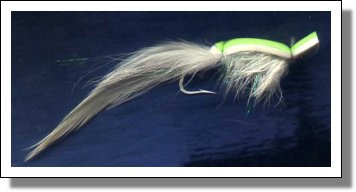
When the wind is low and the water’s surface relatively unruffled, or when fish are obviously feeding on or near the surface, or when fish are lethargic and need a little "stirring up," the Gurgler is my favorite surface fly to fish in both salt water and fresh. The story of the Gurgler and how it developed is described elsewhere on this web site and in my book, Scratching the Surface. These sources describe tying and fishing techniques for the original Gurgler, a pattern I tied and fished for quite a few years and which I continue to use.
But there are other ways to tie a Gurgler, and the Double Gurgler is one of them--a fly so-called because it is tied using two pieces of foam instead of the usual one. This particular variation will bring fish up from depths you wouldn't believe; and it allowed me to experiment with different techniques and configurations and to make good use of the thinner and rather softer foams that are commonly available to many tyers.
What Does a Gurgler Imitate Anyway?
The Gurgler doesn't imitate anything in particular. Rather, depending on how it’s tied, it suggests a food that fish like to eat (baitfish, crabs, frogs, mice, etc.). Its effectiveness derives largely from its ability to create a commotion as it moves across the surface. This commotion, caused by a protruding and upright lip, attracts the fish to the form of the fly, which the fish may then take as the form of a baitfish, a crab, a frog, a mouse or any number of creatures that fish feed on. It’s also been proposed to me by someone who studies the feeding behavior of fish that the sound produced by the Gurgler imitates quite well the sound of a fish feeding on the surface and this can be an additional reason that fish are attracted to the Gurgler. An interesting theory.
Whatever the attraction, the fly certainly attracts fish. Since I first tied it back in the 1980s I've taken hundreds of stripers, bluefish, trout, tarpon, bass, bluegill, barracuda, jacks, and other game fish on Gurglers. I've also devised dozens of variations in a wide variety of configurations, sizes, and colors to suit many different conditions and to appeal to different species of fish, from tiny #16 Trout Gurglers to ten-inch-long 2/0 Pike Gurglers. I've tied Frog Gurglers for largemouth and smallmouth bass, Mouse Gurglers for salmon, steelhead, and large trout in Alaska and Patagonia, and Crab and Spawning Worm Gurglers for tarpon, stripers, bonito, and false albacore, to name just a few.
About Gurgler Foam
I teach a lot of fly tying clinics around the country for clubs, groups, and flyfishing shows. I get to meet a large number of flytyer's whose ideas and questions often inspire me and who--I hope--are sometimes inspired by my own tying and what I can teach them. Two of the most frequent questions I'm asked are, "What kind of foam do you use?" and, "Where do you get your foam to tie the Gurglers?" Often these questions are followed by the statement, "The only foam I can find is too soft, too thin, etc."
To answer these questions: I tie my Gurglers using many different kinds of foam--all closed-cell, of course, for better flotation. For smaller Gurglers (#8 -16), I prefer a softer and generally thinner (1/16" or thinner) foam; for larger Gurglers I use a thicker (1/8" or thicker) and stiffer foam, which is also what I prefer when I want the fly to create a lot of "gurgle."
I get my foam from various sources: fly shops, craft stores, even the local museum trash bins (a good source for thicker--1/4" packing foam). In short, I get my foam wherever I can find foam that can be put to good use. The varieties and sources are endless and I encourage tyers to explore as many as possible.
The Double-Gurgler
One of my favorite closed-cell foams is available at craft stores variously sold under names like Foamtastic, KidzFoam, Foamies, and others. This foam comes in a wide variety of colors, hardness, and sometimes thickness. But usually it is available in 1/16". At 1/16" it is useful for tying many types of floating flies, especially smaller ones.
Doubled-up however (thus making it 1/8” thick), this foam is also very useful for tying the Double Gurgler, so-called because it is tied using two pieces of foam. If you can’t find the stiffer and thicker foam preferable for tying the standard Gurgler, this foam is ideal for tying a wide variety of high-floating, long-lasting, surface-punching Double Gurglers that will bring fish up from depths you wouldn't believe.
If you experiment with different thickness, textures, body lengths and colors, you'll discover for yourself what you can and cannot do with this material. After you've tied up a bunch of them, take your finished flies out to your favorite water and see what they do when played across the surface. This is how I typically go about playing with materials and it adds a lot of fun to my fly tying--which is what fly tying, and fishing, is all about anyway.
To make tying the Double Gurgler even more fun, I've simplified the tying somewhat so that it’s even easier to tie than the original Gurgler. Below is one of my favorite dressings, a Flatwing Double Gurgler, which may be tied on a regular or on a long shank hook, with a long or relatively short foam shell, depending on your needs.
Tying the Double Gurgler (flatwing version)
| Hook: |
Mustad 34007, Daiichi 2546, (reg. shank), Mustad 34011 (long shank), sizes #4-#2/0 |
| Thread: |
Size 3/0 for smaller flies, Size A for larger |
Wing Support (optional): |
Bucktail, tied short and fanned out |
| Tailwing: |
Four straight white saddle feathers, length can vary from 2”-8,” depending on overall size desired. (the best feathers are those taken right off the skin, rather than strung saddle hackle). |
| Tail Flash/ Shell Protector: |
Pearlescent Glimmer or Flashabou |
| Shell: |
A double layer of 1/6” closed-cell foam, chartreuse over white being the colors used in this example. |
| Body: |
Gartside’s Secret Stuff or similar, dubbed and picked out to form a rough and sparkly body |
Ribbing: |
White saddle hackle |
Tying Notes:
Tail Material: While this example of a Flatwing Double Gurgler uses a tail of medium-length saddles, you can also tie it with wider neck hackle to achieve an overall broader profile. I also tie Double Gurglers using a tail of bucktail, marabou, fox, Gartside’s Secret Stuff, and other materials I may be experimenting with. The Double Gurgler is more than a single "pattern" and can be almost infinitely varied to suit one’s needs.
Shell Durability: To tie a Double Gurgler with a more durable shell and a really stiff lip--one that produces an extra-loud gurgle-- double your foam by pressing one untreated sheet of foam against a foam sheet with a sticky back thus bonding the two together. This makes trimming and tying easier.
Lip Modifications: Here’s an interesting twist you might want to try: After tying your Double Gurglers, poke or cut a small hole into the bottom of the two pieces of foam that form the Gurgler lip. You can then pull this piece down and through the eye of the hook to create a quite different action and commotion as the fly is played across the surface. This simple trick can often bring astonishing strikes from otherwise lethargic fish.
Color Combinations: Additional color combinations you might want to add to your tying and fishing palette include all white, white/red, white/yellow, yellow/white, yellow/red, red/white, blue/white, green/white, all black, black/white, dark Lollipop/white, dark Lollipop/black, light Lollipop/white, and light Lollipop/black. (The first color in these color descriptions refers to the shell color, the second to the color of the tail or body hackle.)
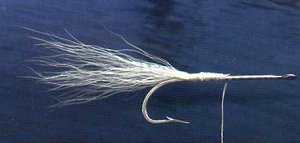 Cover hook shank with tying thread and tie in a short tail of white bucktail just forward of the bend of the hook. Trim excess. With fingers, spread bucktail fanlike to provide broader support for tail.
Cover hook shank with tying thread and tie in a short tail of white bucktail just forward of the bend of the hook. Trim excess. With fingers, spread bucktail fanlike to provide broader support for tail.
Note: if you want to tie a Gurgler whose rear portion will lie lower in the water, tie in the bucktail and all other materials at a point about 1/3 or midway up the hook shank, leaving the rear of the shank bare.
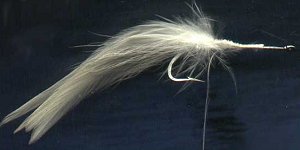 Tie in four or six saddle feathers (concave side down) just forward of the bend of hook and over the bucktail. Trim excess.
Tie in four or six saddle feathers (concave side down) just forward of the bend of hook and over the bucktail. Trim excess.
Tie in ten or fifteen strands of Glimmer or Flashabou at base of saddle feathers, length to reach 2/3 length of tail-wing.
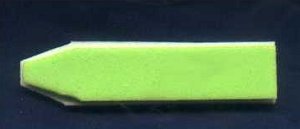 Cut two pieces of foam in roughly equal widths and of a length sufficient to form both shell and lip and trim what will be the rear portion of shell into a taper.
Cut two pieces of foam in roughly equal widths and of a length sufficient to form both shell and lip and trim what will be the rear portion of shell into a taper.
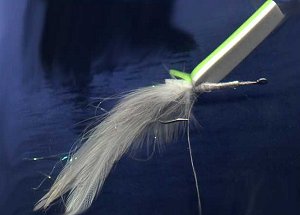 Tie down tapered end of foam just forward of the bend of the hook and at base of tail wing.
Tie down tapered end of foam just forward of the bend of the hook and at base of tail wing.
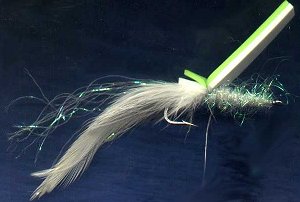 Dub some GSS (Gartside’s Secret Stuff) or similar onto thread and wind forward and back over shank to form a scruffy body. Pick out some strands of GSS so that they will later mingle with the hackle ribbing.
Dub some GSS (Gartside’s Secret Stuff) or similar onto thread and wind forward and back over shank to form a scruffy body. Pick out some strands of GSS so that they will later mingle with the hackle ribbing.
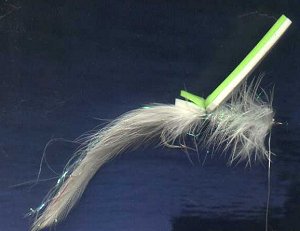 By its tip, tie in a longish saddle feather on top of and at rear of body--and tight up against where you tied down the foam--and wind forward taking care that the last few turns of hackle up near the eye are made using the marabou-like fluff at the base of the feather. Trim excess.
By its tip, tie in a longish saddle feather on top of and at rear of body--and tight up against where you tied down the foam--and wind forward taking care that the last few turns of hackle up near the eye are made using the marabou-like fluff at the base of the feather. Trim excess.
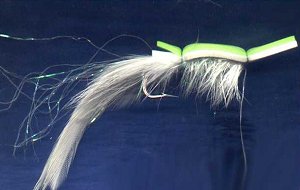 Pull foam forward--to stretch it a little --and over the body. Tie down just behind eye of hook.
Pull foam forward--to stretch it a little --and over the body. Tie down just behind eye of hook.
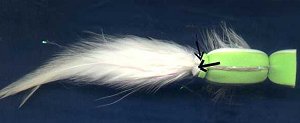 Trim the rear portion of the foam flat and relatively short. Separate six or seven strands of Glimmer from the tailwing overlay and pull them forward tightly over the shell and secure them at a point where you tied down the forward section of the shell.
Trim the rear portion of the foam flat and relatively short. Separate six or seven strands of Glimmer from the tailwing overlay and pull them forward tightly over the shell and secure them at a point where you tied down the forward section of the shell.
(Taking this step has little to do with the overall effectiveness of the fly; it’s taken so that the shell fits more snugly over the body--thus cutting down on wind resistance--and to prevent the foam from being easily chewed up by a fish.)
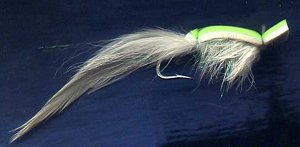 Trim lip to desired height , roughly 1/4” on most flies. Cement thread at head.
Trim lip to desired height , roughly 1/4” on most flies. Cement thread at head.
Hint: if you trim the foam short, to a point just behind the eye of the hook, you will now have a Slider, which will float but can be moved silently over or just under the surface; this can be deadly at times when the water’s surface is too choppy to fish a Gurgler or when the fish are attracted to but are refusing a more noisy Gurgler (this happens at times).






